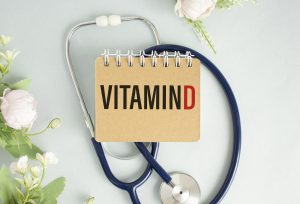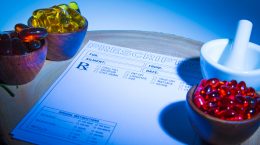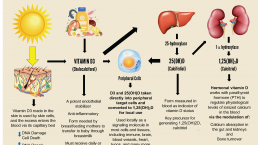Published on November 3, 2023
One of the world’s leading vitamin D experts, Dr. Sunil Wimalawansa, with over four decades of experience with vitamin D in clinical and laboratory practice, answers some of our latest questions.
A 5-Part Interview Series with Dr. Sunil Wimalawansa
Part 1 Vitamin D: Everything You Need to Know… and More: An introduction to Dr. Wimalawansa along with details focusing on his experience with vitamin D in the clinical and scientific setting
Part 2 Defining Optimal Levels and Doses of Vitamin D for Every Individual: Answers to questions about optimal vitamin D levels and doses and how they may differ for certain individuals
Part 3 Understanding the Forms of Vitamin D: Vitamin D3, 25(OH)D, and 1,25(OH)2D:A detailed description of the forms vitamin D3, 25(OH)D, and 1,25(OH)2D and when each might be considered for measurement
Part 4 How Does One Determine the Right Amount and Type of Vitamin D to Take?: Calculating the correct amount of vitamin D to take and when certain forms of supplementation should be considered
Part 5 Vitamin D Safety and Adverse Effects – When Should Caution Be Advised?: Our final post for this series of questions-and-answers with Dr. Wimalawansa on vitamin D safety and toxicity
Key Points (Part 1)
- Dr. Sunil Wimalawansa answers several questions, including “How does such a low-cost vitamin D nutrient help us so much?,” “Why do you think healthcare workers and others are skeptical of the benefits of vitamin D?,” and “Can you give examples of some areas in vitamin D research that must be addressed soon?” while also sharing about some of his greatest accomplishments
- Over 100 clinical studies, including ~30 randomized control trials (RCTs), using vitamin D and calcifediol at appropriate doses and frequency, demonstrate it is highly effective in prevention and treatment; in fact, vitamin D is more effective than all patented COVID-19 vaccines and anti-viral agents in preventing infection, spreading the disease, developing complications, hospitalizations, and deaths
- With appropriate intake (proper dose and frequency), vitamin D holistically helps all body systems. Nevertheless, over 50% of the global population is vitamin D deficient at some time during the year; hence, the ongoing preventable, chronic diseases and sepsis-related millions of deaths.
 “Vitamin D deficiency-induced disorders and related complications are common. However, almost all of these are preventable, and many are treatable”—Sunil Wimalawansa.
“Vitamin D deficiency-induced disorders and related complications are common. However, almost all of these are preventable, and many are treatable”—Sunil Wimalawansa.
Dr. Sunil Wimalawansa has been researching vitamin D for over four decades and is considered one of the world’s leading experts on vitamin D. His extensive background includes working with vitamin D in the laboratory setting from 1983, applying his vitamin D knowledge working with patients as a medical doctor, and facilitating clinical trials involving vitamin D. His book, “Vitamin D: Everything You Need to Know,” is available here on Amazon. A more extensive biography can be found below.
Today, we will introduce Dr. Wimalawansa and share details, focusing on his experience with vitamin D in the clinical and scientific setting. In upcoming posts, we will share Dr. Wimalawansa’s answers to some of our most challenging vitamin D questions on topics including,
- What are optimal vitamin D levels and doses, and do they vary for individuals with certain conditions?
- When to be cautious about vitamin D, and what are the principles governing the use of vitamin D?
- Vitamin D3, 25(OH)D, and 1,25(OH)2D – Which forms should be measured and given as supplements?
- And much more…
Who is Sunil Wimalawansa?
 Sunil Wimalawansa, MD, PhD, MBA, DSc, is a Professor of Medicine, Endocrinology & Nutrition, formerly “University Professor,” Chief of Endocrinology, Metabolism & Nutrition at UMDNJ/Rutgers University, and Professor of Physiology and Pharmacology at the Graduate School of Biomedical Sciences. His Ph.D. was in endocrine receptors and pathology from the University of London, United Kingdom, in 1987. In addition to his medical degrees, he earned a diploma in Medical Administration from Johns Hopkins University School of Business in 2000 and an Executive Master of Business Administration from Rutgers University Business School in 2006.
Sunil Wimalawansa, MD, PhD, MBA, DSc, is a Professor of Medicine, Endocrinology & Nutrition, formerly “University Professor,” Chief of Endocrinology, Metabolism & Nutrition at UMDNJ/Rutgers University, and Professor of Physiology and Pharmacology at the Graduate School of Biomedical Sciences. His Ph.D. was in endocrine receptors and pathology from the University of London, United Kingdom, in 1987. In addition to his medical degrees, he earned a diploma in Medical Administration from Johns Hopkins University School of Business in 2000 and an Executive Master of Business Administration from Rutgers University Business School in 2006.
He has expertise in internal medicine, endocrinology, human nutrition, osteoporosis and metabolic bone diseases, diabetes, obesity, malnutrition, vitamin D, and environmental issues that affect water and sanitation and chronic kidney disease, focusing on disease prevention.
Dr. Wimalawansa is a clinician-scientist with over four decades of experience, a faculty member, medical educator, author, researcher, board member, innovator, administrator, leader, expert witness, and philanthropist. His inventions include vasodilatory CGRP for cardiovascular diseases (prevention of myocardial infarctions, strokes, migraine headaches) and as a treatment for pre-eclamptic toxemia in pregnancy. Concerning musculoskeletal diseases, he invented the once-a-week bisphosphonate use for osteoporosis, combination therapies (anabolic and anti-osteoclastic agents), and nitric oxide regimens for preventing and treating osteoporosis. In 1984, he developed the intra-operative measurement of hormones during surgical procedures, now used worldwide as the standard of care helping millions of patients.
He is a process consultant, Lean Six-Sigma executive, a board of directors of national and international organizations, and was a member of NIH, VA, DEA, and NASA scientific review committees. He received the Lifetime Achievement Award (2004) from a USA Foundation for contributions to science and humanity, the Dr. Boy Frame award for clinical excellence from the ASBMR in 1993, and the Oscar Gluck International Humanitarian Award (2008). Dr. Wimalawansa has published over 300 peer-reviewed research articles with over 11,000 citations and has written five medical books. He has conducted 250+ medical education-related teaching/training programs in several countries. He delivered over 500 invited national and international lectures and scientific presentations and is the author of the book, “Vitamin D: Everything You Need to Know,” available on Amazon. His recent focus is on micronutrients, especially vitamin D, and optimal ways to use it and its metabolites to prevent and overcome diseases.
Questions and Answers with Dr. Wimalawansa
As a leading physician-scientist, what is your focus in medicine?
I was trained as a physician in traditional internal (acute) medicine, specializing in endocrinology, metabolism, and nutrition. Three decades ago, my focus changed from “treating” diseases to “preventing” them, incorporating holistic medicine. My presentations, clinical research activities, and scientific publications reflect this.
In addition to endocrinology and nutrition, my areas of interest extend to the prevention of chronic kidney disease of unknown etiology (CKDu) via the provision of potable water, better nutrition and avoiding harmful habits, and viral illnesses like influenza and SARS-CoV-2 via naturally stimulating the immune response using micronutrients, especially vitamin D. Folling is an example of disease prevention without medication.
A couple of years ago, after decades of research, we identified the mysterious cause of this silent disease that kills over 25,000 middle-aged men each year—a natural cause arising from underground seismic activities leading to water contamination with high concentrations of CaPO4, fluoride, etc. (doi.org/10.3390/environments7010002). Chronic consumption of such contaminated water from deep wells (but not from surface water) with chronic sustained dehydration led to nano-crystal formation with CaPO4‒F- in kidneys, leading to renal failure and death (doi.org/10.1186/s40001-023-01162-y). So, we changed the name from CKD of unknown etiology (CKDu) and CKD of multi-factorial (CKDmfo) to crystal-tubular nephropathy (CTN). CTN is reversible by changing harmful habits and consuming clean water without medicine.
Can you briefly share more about your past and present clinical and research experience and how it led you to focus on vitamin D?
I have been interested in endocrinology—curious to understand mechanisms—since I was a medical student. I was one of the four members instrumental in developing the first nuclear medicine laboratory and the first comprehensive thyroid clinic in Sri Lanka in 1974 at the University of Peradeniya. There, I developed the first four radioimmunoassays to measure thyroxine, estrogen, B12, and folate for Sri Lanka.
I participated in two clinical fellowship training programs (Manchester and London) and postgraduate studies at the Royal Postgraduate Medical School, world-famous Hammersmith Hospital in London, UK, where I completed a PhD in 1987 in Endocrine Pathology. Between 1982-1986, I had the opportunity to take part in peptide and receptor research, osteoporosis, Paget’s disease, and hyperparathyroidism-related research, as well as in vitro studies with vitamin D. One of these projects was to study the effects of vitamin D on different cancer cell lines. We demonstrated that activated vitamin D is a potent inhibitor of cell division, and it stabilized cell growth and prevented differentiation into cancer cells.
My vitamin D-related clinical work was initiated as a tenured Professor of Medicine and endocrinology at the University of Texas Medical Branch at Galveston between 1994-2000. We demonstrated that vitamin D prevented adverse effects, such as osteomalacia and bone fractures, in persons with osteoporosis when using bisphosphonates. In collaboration with Prof. Yallampalli, we developed a rat model for pre-eclamptic toxemia; we demonstrated that calcitonin-gene-related peptide (CGRP) reversed in this model of toxemia in pregnancy.
I was the first to develop once-a-week bisphosphonate therapy using alendronate and later nitroglycerin donor therapy to prevent bone loss (initially in animal models) in postmenopausal osteoporosis in human clinical studies (brought these from the research bench to clinic). In clinical practice, we routinely used upfront loading doses of vitamin D, using 50,000 IU capsules, to raise serum 25(OH)D and fill up storage tissues to expedite its benefits. We demonstrated that the number of vitamin D capsules needed depended on the serum 25(OH)D concentrations or the body weight, making it easier to use. These cost-effective regimes use high doses of vitamin D are illustrated in the Vitamin D book and our peer-reviewed papers.
As the Chief of Endocrinology & Nutrition at the University of Medicine & Dentistry in New Jersey (Med School), from 2001 onwards, this work was extended. Among others, we also conducted an NIH-funded, single-center, extensive osteoporosis prevention RCT in postmenopausal women, using nitroglycerine, to test the effectiveness of nitric oxide donors. In all our human clinical studies, we included vitamin D as a safety measure and commonsense procedure.
We routinely used vitamin D as a single (bolus) dose at the onset to raise serum levels. We followed up with daily or weekly maintenance doses to keep the circulating 25(OH)D levels between 30 and 60 ng/mL. For those with multiple sclerosis and other autoimmune disorders and in specific comorbidities, we maintained serum 25(OH)D levels between 60 and 80 ng/mL from 2001. There were tremendous clinical benefits for patients using this cost-effective, straightforward regimen that demonstrated subjective and objective improvements. We observed that compared to baseline, the relapse rates of multiple sclerosis decreased to less than 20%. Several other international groups are successfully following variations of this protocol now.
How does such a low-cost vitamin D nutrient help us so much?
Globally, vitamin D deficiency is the most prominent nutrient deficiency; before, it was iron deficiency. Daily or weekly intake is the best—intermittent intakes beyond once a month are inferior and would not help. With appropriate intake (proper dose and frequency), vitamin D holistically helps all body systems. Nevertheless, over 50% of the global population is vitamin D deficient at some time during the year. Hence, the ongoing preventable, chronic diseases and sepsis-related millions of deaths.
Vitamin D has multiple overlapping mechanisms developed evolutionarily and designed to protect humans from internal (metabolic and oxidative abnormalities) and external (environmental and pathogens) harm. Its canonical actions work via modulating (and repairing) DNA (genomic). However, vitamin D also has critical non-genomic activities, like acting on membranes and intracrine/autocrine and paracrine signaling mechanisms. These non-transcriptional mechanisms are essential in controlling inflammation, preventing endothelial and epithelial cell destabilization, and keeping humans healthy.
Calcitriol, the fully activated vitamin D, down-regulates inflammation and oxidative stresses by suppressing inflammatory cytokines and enhancing the synthesis of anti-inflammatory and anti-oxidant cytokines (10.1210/jcem.86.2.7220). Immunomodulatory effects of vitamin D include activation of immune cells such as T and B cells, macrophage and dendritic cells, microbial peptides like cathelicidin (LL-37) that neutralize circulating viruses, and enhanced production of neutralizing antibodies.
Why do you think healthcare workers and others are skeptical of the benefits of vitamin D?
I was asked similar questions by physicians who spent time in our clinics, including trainee fellows and others, including when I presented data in scientific and clinical meetings. “How would it work? Seems it is working, but how could it be true? It is too simple to believe.” It became simpler when one understood the biology and physiology of vitamin D and its interactions with body systems, especially the immune system.
We learned further from the SARS-CoV-2 pandemic reporting via over 100 clinical studies, including ~30 randomized control trials (RCTs), using vitamin D and calcifediol at appropriate doses and frequency, is highly effective in prevention and treatment ( https://c19early.org/d ). While most pertinent information is suppressed in the media and prevented publishing in medical journals, vitamin D is more effective than all patented COVID-19 vaccines and anti-viral agents in preventing infection, spreading the disease, developing complications, hospitalizations, and deaths. https://covid19criticalcare.com/understanding-vitamin-d/
We leveraged these data and platforms to further understand and implement our knowledge into clinical practice, especially for immunology. These helped tremendously during the COVID-19 pandemic, but unfortunately, regulators and leading health agencies minimized the value of using already approved, repurposed generic agents. Based on established knowledge and common sense, the first peer-reviewed publication recommending high doses of vitamin D was published on 28th February 2020 (Wimalawansa, SJ, Controlling COVID-19 pandemic with cholecalciferol. World J Adv, Healthcare Res. https://wjahr.com/admin/assets/article_issue/25122020/1642764902.pdf )
What type of research are we now going to need to enhance the field of vitamin D?
Research needs to focus on several clinical areas related to vitamin D to test specific hypotheses (i.e., to fill the gaps in knowledge). As we will discuss shortly, the full biological functions of the “Vitamin D‒System” need sufficient cofactors, such as magnesium (the ratio of Ca2+/Mg2+ in the biological milieu‒NOT in the blood itself), zinc, boron, etc.
There is no straightforward way to assess the quantities and needs of cofactors or obtain cofactors economically as supplements. This is a commercial opportunity for a local health-food company to develop (taking safe daily or preferably once a week) proper concentrations of sufficient cofactor supplements in a capsule to fulfill this gap.
Can you give examples of some areas in vitamin D research that must be addressed soon?
There are contradictory publications and myths regarding the connections between clinical outcomes, like gut microbiota and micronutrients, and proper use of vitamin D metabolites and their synthetic analogs is another area that needs exploring. Researchers must comprehend that in vitro cell and organ culture data and in vivo small animal studies cannot directly extrapolate to human physiology or the needs.
We also need to explore what benefits, other than vitamin D3, are provided to us by nature via safe sun exposure. It is essential to conduct adequately designed focused studies, but not necessarily RCTs, “testing” specific hypotheses: such studies are needed to confirm a direct “cause-and-effect” relationship between vitamin D, micronutrients, and other cofactors. Piggybacking vitamin D as a supplement on ongoing pharmaceutical studies (usually done to discredit it or satisfy regulators) or ad-hoc clinical research neither answers the pertinent questions nor achieves the desired results.
What is most disheartening is that some researchers, societies, and government-appointed scientific groups continue to rely on outdated publications and refuse to incorporate the knowledge published during the past 15 years. Thus, they and the authors of meta-analyses provide unhelpful and outdated guidance and repeat the jargon that “more RCTs are needed before recommendations can be updated.” These robotic responses are disappointing.
What do you enjoy doing when you are not researching vitamin D?
In the past, my passion was for outdoor activities—expeditions, canoeing, cycling, climbing, hiking, etc. With time, we have to reduce the intensities of these. Almost all activities I am currently engaged in, including lectures, participating in many international groups and societies (mostly related to disease prevention), and training courses, are pro bono.
I have served on the board of directors for several national and international scientific and medical societies and charitable organizations, where I emphasized the importance of disease prevention. Over the past two decades, I have been involved in several international disease prevention programs extending this mission. This includes writing protocols, designing randomized control clinical trials, conducting free training programs and courses in bone mineral density testing and general endocrinology in developing countries, helping patient advocacy groups, etc.
Read Part 2 of this Interview Series: Defining Optimal Levels and Doses of Vitamin D for Every Individual
* The above is a scientific discussion and should not be considered medical advice. Regarding clinical or personal issues, Prof. Wimalawansa advises readers to consult her/his physician.
Test to See if You Are Getting Enough Vitamin D
 Create your custom home test kit to measure your levels at home as part of the D*action project!
Create your custom home test kit to measure your levels at home as part of the D*action project!
With your kit you can measure your:
- Vitamin D
- Magnesium PLUS Essential and Toxic Elements
- Omega-3 Fatty Acids
- hsCRP
- HbA1c
- TSH
- Type 1 Diabetes Autoantibodies
Did you know that each of the above can be measured at home using a simple blood spot test? As part of our ongoing research project, you can order your home blood spot test kit to get your levels, followed by education and steps to take to help you reach your optimal target levels. Start by enrolling and ordering your kit to measure each of the above important markers, and make sure you are getting enough of each to support better mood and wellbeing!
Create your custom home test kit today. Take steps to improve the status of each of these measurements to benefit your overall health. With measurement you can then determine how much is needed and steps to achieve your goals. You can also track your own intakes, symptoms and results to see what works best for YOU.






